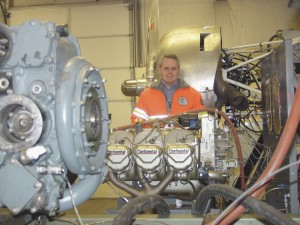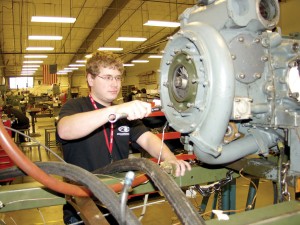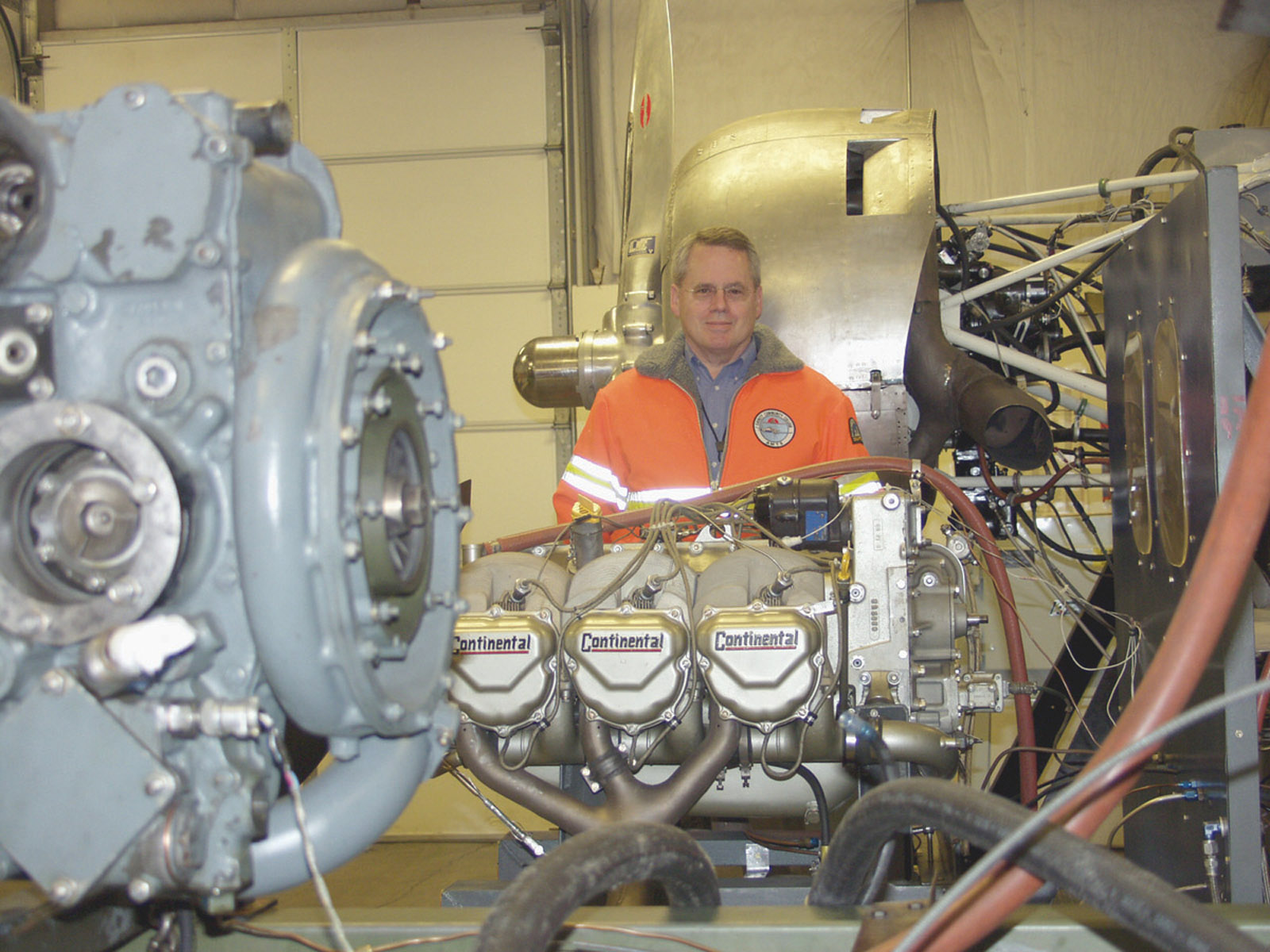By Terry Stephens,
Fundraising is underway for $1 million to expand Everett Community College’s aviation maintenance technician program at Snohomish County Airport (Paine Field). The $1 million could grow to $2 million after community matching funds. A newly created technology center on the 4.5-acre site would include aviation, welding, fabrication and manufacturing engineering programs.

Bill Loomis, director of Everett Community College’s aviation maintenance training center at Paine Field, oversees classes that include training on both reciprocal and turbojet engines.
“We’ve had an aviation mechanics program at Paine for 38 years,” said Bill Loomis, director of the school’s aviation program. “Now, as the college is expanding in Everett, we’re asking what we can do here to increase our presence. With the $2 million total, we could establish the tech center.”
Everett Community College’ current aviation program is housed in 48,000 square feet of training space and offices in three attached buildings. Shortly after 9/11, 25 students were enrolled in the program, but that number has now doubled. The facility can handle up to 100 students, Loomis said, noting that he expects enrollment will soon be back at its average level of 65 students.
“People are coming back to aviation and aviation maintenance,” Loomis said. “Normally, this is a day program, but we could go past the 100 limit by adding evening classes. We’ll step up to increasing demand as it comes.”
He said they always strive to keep class sizes manageable.
“To maintain the quality of instruction, the FAA limits us to 25 students per instructor,” he said. “I don’t want to just push larger numbers of students through, if it means they aren’t going to be able to get plenty of individual instruction and have time to really absorb everything.”
Earl Brown, Pat Murphy and Tom Hatton are the three advisors and instructors who assist Loomis in the program. Students spend 40 percent of their time in classrooms. They spend the rest of their time in the lab, repairing engines, making composite materials and learning how both reciprocal and turbine engines operate.
A certificate from the program allows graduates to take Federal Aviation Administration exams for airframe and power plant licenses. Combined with academic programs, the aviation center also provides associate degree programs. These include a degree in technical arts and aviation and another in arts and sciences, with an emphasis on aviation maintenance management opportunities (such as foremen, supervisors and inspectors).

Erik Hager, Lynnwood aviation mechanic student, is building on his automotive background. He plans to eventually work with charter and airline aircraft, and is considering working towards an aviation management degree.
“With a minimum of 1,900 hours of training, we cover 43 different subject areas, from welding and hydraulics, to engines and airframes, as well as composites and machining metals and even things like filling out proper forms and safety programs,” said Loomis.
He’s proud the program has survived as one of 153 similar schools in the United States. About 20 years ago, the number of these schools was nearly 300.
Overall, the program provides eight quarters, or 2,040 hours, of study that include hands-on work on a variety of fixed-wing aircraft and helicopters. A hangar, attached to the classroom and laboratory buildings, houses more than 10 aircraft, including a military Huey helicopter, an OH-58A Army equivalent to a civilian Bell JetRanger, and an Air Force T-39. In 1963, the T-39 became the basis for the Sabreliner Model 40, the world’s first twin-engine business jet.
“We don’t fly them, but we look for planes that are complete, so our students can work on them,” Loomis said. “When we get retired military aircraft from a government surplus program, we always make sure the plane has a civilian counterpart, so the training has broader employment applications.”
One of the most recent aircraft acquired was “Zippy,” an operational, well-maintained Cessna 205. Honeywell International, which has a facility adjacent to the college’s aviation facility, had flown “Zippy” as an avionics test bed. Students will periodically tear down the aircraft, overhaul the engine, remove wheels and brakes, rig its flight controls and install new radios and flight instruments. They’ll even run up the engine occasionally to test operating systems.
In 2004, S&S Turbine Services Ltd. donated two J57 turbojet engines for student lab work. The engines were in prime condition and each was worth $250,000. The company also covered the cost to ship the engines to Paine Field from Tucson, Ariz.
The college’s program also shares a $1.4 million Department of Labor grant to the TRIAD partnership, and is responsible for training workers in composites and advanced technologies. The partnership includes Everett and Edmonds community colleges; The Boeing Co. and other manufacturing industries; the Snohomish County Workforce Development Council and the county’s economic development council.

Pat Murphy, an airframe instructor at Paine Field’s aviation school, shows off some of the aircraft used to train aviation mechanics.
“We’re in discussions now with Boeing and Goodrich (Aerospace Services) to help them with workforce needs,” Loomis said. “Also, the community colleges have an FAA grant to promote technical competency in advanced maintenance skills, specifically for the type of composite structure that makes up 70 percent of the new 787.”
Instructor Tom Hatton, who works with students on power plants, went through the course himself for a career change. After 30 years of electronic products repair, he saw the trend shift to replacing items, rather than repairing them. After becoming an aircraft mechanic, he worked for Goodrich in quality control, and for Methow Aviation, before joining the Everett Community College program.
“Employment for our graduates isn’t all in the county,” Hatton said. “One went to Venice to work with Al Italia. Some go into turbine engine work in the marine industry. Students grind valves, overhaul a variety of reciprocating and jet engines and prepare to take oral, written and workshop FAA exams.”
Pat Murphy, an instructor who works with composite technology, likes to show off a $17,000 piece of portable equipment, packed into an aluminum case. It’s used to train students how to understand and repair composite material. The state-of-the-art gear is one of the benefits from a grant shared with Edmonds Community College, a school that focuses on engineering programs.
“Small pads of composite materials are heated in the case, to temperatures that allow students to repair the damaged composite,” Murphy said. “These composites are made of woven carbon fiber impregnated with epoxy resins.”

An Air Force T-39, comparable to the civilian Sabreliner, is the latest of nearly a dozen aircraft available for aviation mechanic training at Everett Community College’s Paine Field hangar.
Loomis said the school depends on the aviation industry for aircraft and equipment donations, along with other assistance.
“Students can never get enough leading edge technology to work on,” he said. “That’s always a challenge for a public college with a limited budget, so donations of aircraft, engines and equipment are a tremendous help.”
Loomis works closely with an aviation advisory committee that offers direction on the school’s curriculum, operations and future path. Members include Dave Waggoner, Paine Field director; Barry Smith, Future of Flight Center executive director; and representatives from Boeing and Alaska Air, among others.
Loomis, a veteran of Navy, Air Force and Coast Guard service, said students coming to the center at Paine field have a great peripheral advantage, because of the college’s location, adjacent to runways and taxiways at one of Washington’s largest general aviation airports.
Neighbors of the college include Boeing’s giant assembly plant for its 747, 767, 777 and 787 airliners; Goodrich’s airliner maintenance and modification facility, which is the nation’s largest; the airport’s flight training and maintenance services; and Embry-Riddle University’s Northwest aviation training center. Across the runway is the newly opened $23.5 million Future of Flight Center and Boeing Tour facility that focuses on past and future airliner technology. Displays include a 787 composite fuselage section and three-dimensional holograms, technology that soon may be used for training mechanics more quickly, by allowing them to disassemble and rebuild virtual engines.
“This training center is the starting point for many people who are going to make aviation maintenance a career,” Loomis said. “It’s a crossroads where people of different backgrounds, ages and cultures train together for a lot of different reasons. Some are out of high school, and some are from the military or other career fields. We also have a fair number of international students. These students often go to work for international airlines that fly into this country, because those airlines need a percentage of maintenance staff holding U.S. ratings.”
Loomis said some graduates find jobs with Boeing, Goodrich, the airlines or other aviation employers. Others have specific goals. One student planned to go into missionary aviation, and another into helicopters. One student wanted to work in Alaska’s bush flying environment, while another wanted to restore vintage aircraft.
“Those who enroll here have a real purpose, so they’re excited about being here,” he said.
Overall, the aviation technology school at Paine Field is a major asset. The college will be engaged in the spiraling growth of aerospace technology, linking that technology to the real world by passing it on to students who are looking to work in many new arenas. But with all the talk of new aviation technology, instructor Pat Murphy likes to remind people not to forget the past.
“We may be into composite materials now, but we can’t forget the thousands and thousands of riveted aircraft with older engines and airframes, which will need people to work on them for years to come,” he said.
All training and tests for the program are conducted in classrooms and shops at Paine Field.
For more information, individuals may visit the school at Paine Field, call 425-388-9533 for an appointment or email mlyle@everettcc.edu.











